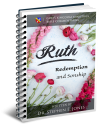Latest Posts
View the latest posts in an easy-to-read list format, with filtering options.

The book of Ruth is the Bible's primary illustration of the law of sonship found in Deuteronomy 25. The story also illustrates the principles of New Covenant marriage as God set forth from the beginning. In addition, it is a natural sequel to the last five chapters of the book of Judges, showing the moral contrast between the home towns of Saul and David as a way of explaining the failure of Saul and the success of David.
Category - Bible Commentaries

The law of illegitimate birth in Deut. 23:2, 3 was not meant to be a permanent ban on Moabites entering the kahal (assembly, church). Likewise, the meaning of “illegitimate birth” is defined to some extent by biblical examples.
One major example is seen in the story of David, who was the tenth generation from Judah, whose incest with his daughter-in-law, Tamar, brought forth Pharez (Gen. 38:29). Judah’s sin delayed the coming of the king for ten generations.
Boaz was the seventh generation from Pharez, and so even though he came short in no other way, he was still affected by the sin of his forefather, Judah. Three more generations would have to pass before the king could arise in Israel without legal encumbrance.
The same can be said of Ruth herself, who was encumbered by her own ancestor, Moab, who was born of illegitimate birth (incest). The difference is that Lot lived three generations before Judah, and hence, it was ten generations from Lot to Ruth.
Lot was Abraham’s contemporary, and though he was Abraham’s nephew and thus of the next generation, Isaac himself was not born until Abraham was a hundred years old. The generations from Abraham are Isaac, Jacob, and Judah, who incurred the curse of illegitimate birth upon that ruling tribe. Hence, it was 13 generations from Abraham to David, or 14 generations, reckoned inclusively (Matt. 1:17), and it appears that the same number of generations had passed from Lot to David.
After Moab’s cursed line had run its course for ten generations, God worked in Ruth’s heart, calling her out of her father’s country, and turning her into an Israelite of the tribe of Judah to prepare for the birth of the coming king (David).
Ruth also provides us with an example of the proper application of the law of equality, which we read in Num. 15:15, 16,
15 As for the assembly, there shall be one statute for you and for the alien who sojourns with you, a perpetual statute throughout your generations; as you are, so shall the alien be before the Lord. 16 There is to be one law and one ordinance for you and for the alien who sojourns with you.
The law, then, applies equally to Israelites and “aliens.” The same judgment of the law upon Lot for his sin of incest applied equally to the tribe of Judah. Just because the law had not been revealed or written down until later (Moses) does not mean it was not in effect earlier. The law expresses the unchanging nature of God and reflects His standard of righteousness. Hence, the law is constant and timeless.
In later years, the Jews discriminated against foreigners (non-Jews), making them unequal, thus violating the law of God and offending His nature itself. They built a “dividing wall” in the courtyard of the temple, which forbade Jewish converts and even Jewish women from drawing near to God. This wall was abolished by Christ and His teachings (Eph. 2:14, 15) in order to create “one new man,” a nation of all ethnic groups that was unified in Christ.
Judaism also discriminated against other ethnicities by setting forth the main law for Jews and “Noahide laws” for non-Jews. The idea was that the Noahide laws in Gen. 9:6, 7 were the only laws that “gentiles” were required to know and obey. Rabbinical writers considered non-Jews to be on the order of cattle who were incapable of morality and truth, even to the point where their testimony in court was not valid.
Such religious traditions are still an abomination to God to this day, for God’s law forbidding such attitudes still stands.
So we see that the law of illegitimate birth applied equally to the descendants of both Judah and Lot. For Lot, it ended with Ruth; for Judah, it ended with King David.